Cookbook #212: Knudsen Recipes, Knudsen, Knudsen Creamery Co. of California, 1958.

This is the third of my mother’s “Knudsen Recipes” cookbooks that I have covered: 1953 was the first, 1955 the second.
I like this edition because it is very much like the 1955 version. Again, the first page illustrates a male chemist in the lab. This time he is dripping something from a big round separatory funnel into a round bottom flask. If he adds much more solution, it will definitely overflow. Plus, why is the lower flask suspended? He is not heating that flask, and it would make more sense to have it on a solid surface, and to use an erlenmeyer flask. (The organic chem lab teacher in me never quits.)
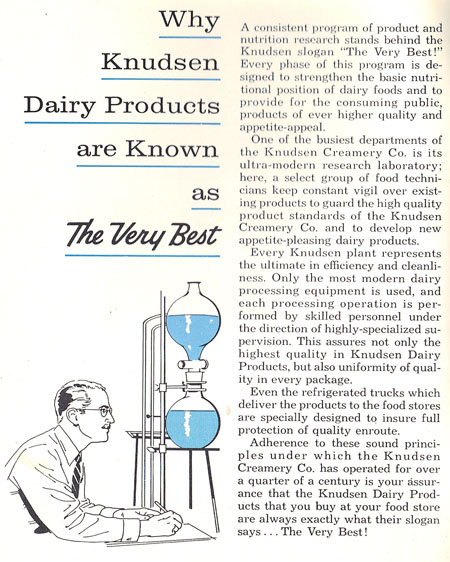 And as in the 1955 edition, it is a woman who is doing the cooking, or at least reading the cookbook.
And as in the 1955 edition, it is a woman who is doing the cooking, or at least reading the cookbook.
 The first section is Appetizers and Spreads. Mother marked several: Crab Meat Canapes, Salami-Julienne Spread, and Cheese Onion Balls. These are all made with cream cheese, cottage cheese, and/or sour cream, with additions of canned or frozen products. During the 50s, and especially during the cocktail hour, these types of appetizers were a mainstay of American cookery.
The first section is Appetizers and Spreads. Mother marked several: Crab Meat Canapes, Salami-Julienne Spread, and Cheese Onion Balls. These are all made with cream cheese, cottage cheese, and/or sour cream, with additions of canned or frozen products. During the 50s, and especially during the cocktail hour, these types of appetizers were a mainstay of American cookery.
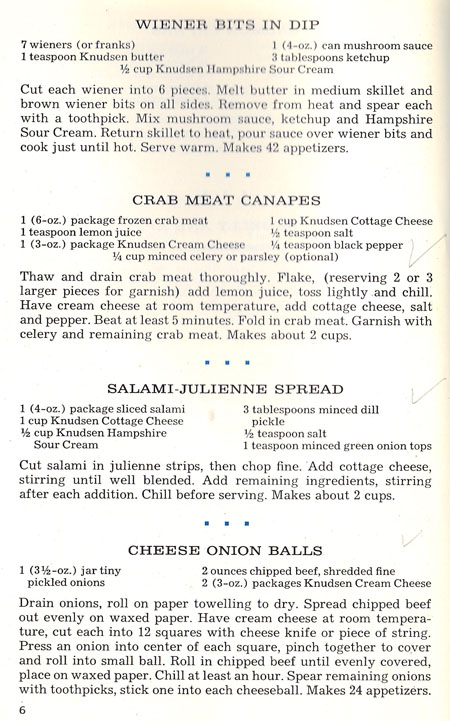 Here is a photo of some of the appetizers:
Here is a photo of some of the appetizers:
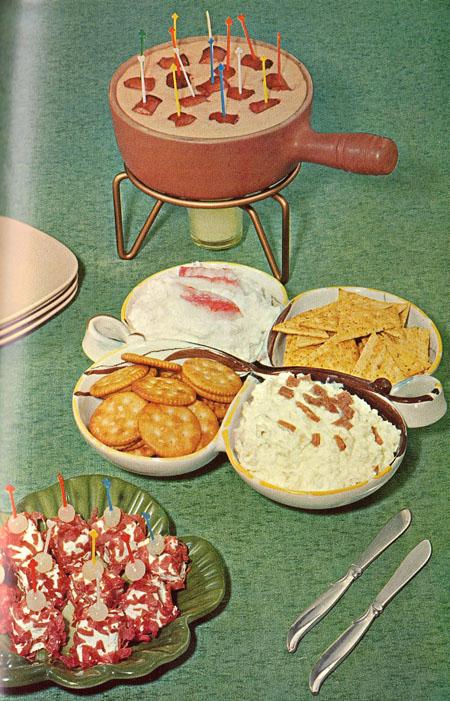 Next is Salads. Mother put a check mark on “Carrot and Red Cabbage Salad”. I thought about making this salad, since I like the combination of carrots and cabbage, but this recipe has more sour cream than I think I’d like. A “Full Meal” salad mixes leftover cooked meat with canned or fresh vegetables and a lot of cottage cheese and sour cream. Not for me. Nor are the molded salads. I guess this whole chapter is just not for me!
Next is Salads. Mother put a check mark on “Carrot and Red Cabbage Salad”. I thought about making this salad, since I like the combination of carrots and cabbage, but this recipe has more sour cream than I think I’d like. A “Full Meal” salad mixes leftover cooked meat with canned or fresh vegetables and a lot of cottage cheese and sour cream. Not for me. Nor are the molded salads. I guess this whole chapter is just not for me!
In the Main Dishes chapter, most of the recipes use about a cup of sour cream and/or cottage cheese per recipe. “Spaghetti with Beef in Hampshire” is a dish of steak, herbs, canned mushrooms, canned tomato soup, Worcestershire sauce, and sour cream, cooked and served over spaghetti. “Spaghetti Cheese Pie” is cooked spaghetti spread in a pie pan and covered with bacon, mushrooms, eggs, cheddar cheese, and cottage cheese and then baked. Both of these typical homey 50s recipes might taste good, but just aren’t the way I cook today. “Baked Potato, The Great American Dish” – baked potatoes with sour cream and chives – was also in the 1955 edition of Knudsen Recipes.
Right in the middle of the Main Dishes chapter I find a recipe for “Cherry Muffins”. Why here? I really don’t know. But I like the recipe, because I am always looking for new muffin recipes and this one has cottage cheese (protein and calcium) in the batter along with a can of tart red cherries (tart cherries are supposed to be good for you). Note all of the recipes on the page below: they are good examples of the type of recipes in this cookbook.

Perhaps Cherry Muffins were meant to be served with supper, or on a buffet, as in the photo below. The muffins are in the lower right hand corner:

Also in the Main Dish chapter is the following recipe for “Zucchini Dollar Cakes”. I think the recipe sounds kind of good. And it might come in handy in late summer, when all those zucchini squashes are out there.

In the Vegetables chapter, most of the vegetables are heavily sauced. Except “Broccoli in Almond Sauce”, which has just a little sour cream. But it calls for frozen broccoli. I prefer a little seasoning on lightly cooked fresh vegetables. I do like the idea of adding cottage cheese to mashed potatoes, one of the other recipes in this section.
Desserts and Sweets is the best chapter for recipes that include sour cream and cream cheese, in my opinion. We expect desserts to have calories, and getting those calories from milk products might be better for us. Examples are: “Cream Cheese Pie”, “Cheese Cake”, “Viennese Apple Strudel” (with cream cheese, butter, and a lot of apples), and “Sour Cream Boston Cheese Cake”. I am marking “try” on the recipe for “Hampshire Sour Cream Spice Cake”, with cottage cheese, sour cream, and lots of spices. It is baked in a bundt pan.
The closing pages of Knudsen Recipes include lists of menus, ideas for using Knudsen products for “weight control for better health”, and a table of calories in a few foods and recipes in this cookbook.
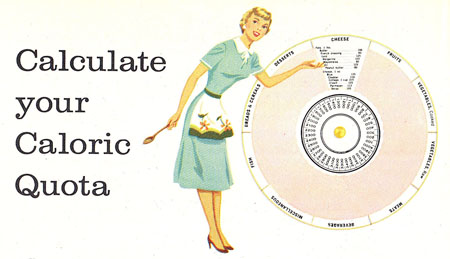 Next is a rave for all the good things about yogurt, hoop cheese, and milk. “Looking for New Ideas? Ways to use cottage cheese” lists a page of ideas. The following one is my favorite. “The men like this with old-fashioned hot potato salad.”
Next is a rave for all the good things about yogurt, hoop cheese, and milk. “Looking for New Ideas? Ways to use cottage cheese” lists a page of ideas. The following one is my favorite. “The men like this with old-fashioned hot potato salad.”
 “Looking for New Ideas? Ways to use sour cream” is next, and here is my favorite from that list. “Gourmets babble?”
“Looking for New Ideas? Ways to use sour cream” is next, and here is my favorite from that list. “Gourmets babble?”

And that’s the book. I decide to make the “Cherry Muffins” for this blog. Here is the recipe (again):
 The first issue I need to address in baking these muffins is the “2 cups prepared biscuit mix”. Biscuit mix, or “Bisquick”, was a staple in American kitchens in the 1950s. It is still available today. Should I purchase a box of Bisquick to make this recipe? I think not. I have no other use for it, and in general, I like cooking from scratch, so that I know my ingredients. Luckily, at some time in the recent past I had copied from the web search results for a substitution for biscuit mix:
The first issue I need to address in baking these muffins is the “2 cups prepared biscuit mix”. Biscuit mix, or “Bisquick”, was a staple in American kitchens in the 1950s. It is still available today. Should I purchase a box of Bisquick to make this recipe? I think not. I have no other use for it, and in general, I like cooking from scratch, so that I know my ingredients. Luckily, at some time in the recent past I had copied from the web search results for a substitution for biscuit mix:
“For each 1 cup biscuit mix (like Bisquick) called for in a recipe, use 1 cup all-purpose flour, 1 1/2 teaspoons baking powder, 1/2 teaspoon salt and 1 tablespoon vegetable shortening.”
I decide to use a combination of unbleached all purpose flour and whole wheat pastry flour, and to use butter instead of vegetable shortening. Also, the cottage cheese I have is very salty, so I am going to cut down the amount of salt. Below is my version of “Cherry Muffins”.
- 1 cup all purpose flour
- 1 cup whole wheat pastry flour (you can use all purpose flour instead)
- 1 tablespoon baking powder
- 1/2 teaspoon salt
- 1 teaspoon cinnamon
- 1 egg
- 1/2 cup sugar
- 3/4 cup milk
- 1/2 cup cottage cheese
- 4 tablespoons melted butter, preferably unsalted
- 1 cup (one can, 13 oz.) tart red cherries, unsweetened, the kind used to bake cherry pies
Combine the flour(s), baking powder, salt, and cinnamon. Set aside.
Put the egg in a good sized bowl and whisk it a few times. Add the sugar, milk, cottage cheese, and melted butter. Mix well.
Chop the drained cherries. These cherries will be very wet and soft, and I didn’t get them totally drained. No problem, just scoop them into the bowl with the wet ingredients.
Combine the wet ingredients with the dry ingredients and stir just until mixed. Put into 12 muffin cups. Bake at 400˚ 20-22 minutes, until golden brown and test done with a toothpick.
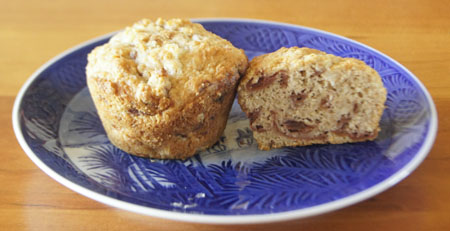 These were a lot better than I expected! I was concerned that the cherries would not lend enough flavor to the muffins, but I was very wrong. Also, I often use vegetable oil in muffins, but used butter in these. Same calories, but what a difference in texture! These almost taste like pie crust.
These were a lot better than I expected! I was concerned that the cherries would not lend enough flavor to the muffins, but I was very wrong. Also, I often use vegetable oil in muffins, but used butter in these. Same calories, but what a difference in texture! These almost taste like pie crust.
Success! I was able to use healthy ingredients, like tart cherries and cottage cheese, to make delicious morning muffins. Probably current and future readers will find nutritional problems with my recipe, as opinions and science are in flux. But for now, I will enjoy my semi-healthy muffins!

 This booklet of 26 recipes must have come with our Weber gas grill. I have forgotten all about this cookbook, since soon after getting the grill I purchased Weber’s Real Grilling, a large cookbook with tons of recipes.
This booklet of 26 recipes must have come with our Weber gas grill. I have forgotten all about this cookbook, since soon after getting the grill I purchased Weber’s Real Grilling, a large cookbook with tons of recipes.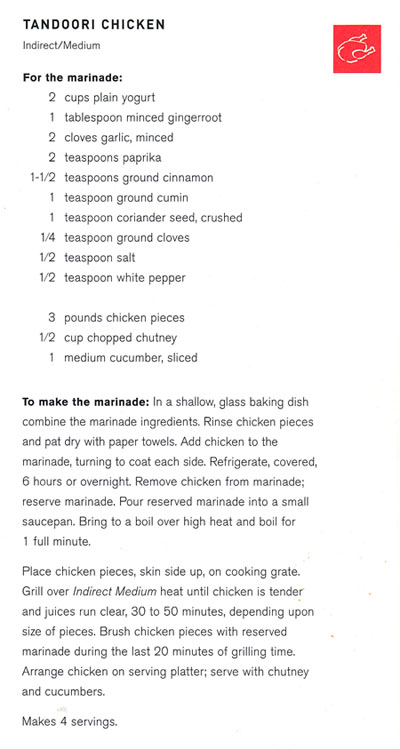
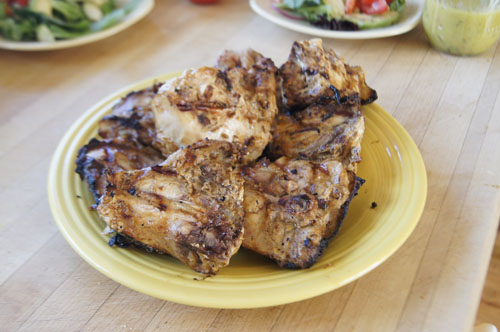 These tasted great! The yogurt marinade makes them not only well seasoned, it also makes them very tender. (I put the blackened side down for the photo. They would have been so much prettier if I hadn’t tried something experimental!)
These tasted great! The yogurt marinade makes them not only well seasoned, it also makes them very tender. (I put the blackened side down for the photo. They would have been so much prettier if I hadn’t tried something experimental!)

 I took the eggs out of the carton in the same order and laid them on a cloth with the upper ends to the right for each egg. Note how hard it can be to find the flatter end – sometimes both ends look the same.
I took the eggs out of the carton in the same order and laid them on a cloth with the upper ends to the right for each egg. Note how hard it can be to find the flatter end – sometimes both ends look the same.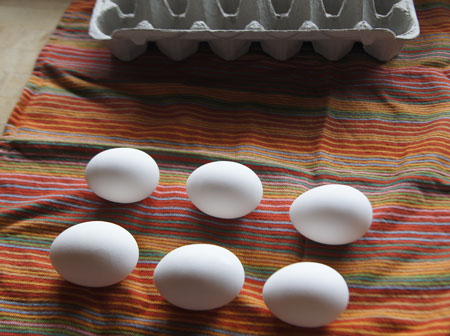 Below is a close-up of these same eggs. I am tilting one egg, flat side up:
Below is a close-up of these same eggs. I am tilting one egg, flat side up: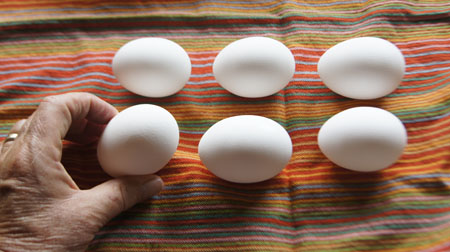
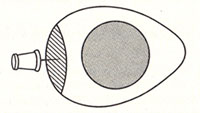
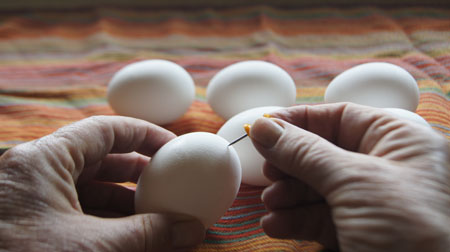 Poked hole:
Poked hole: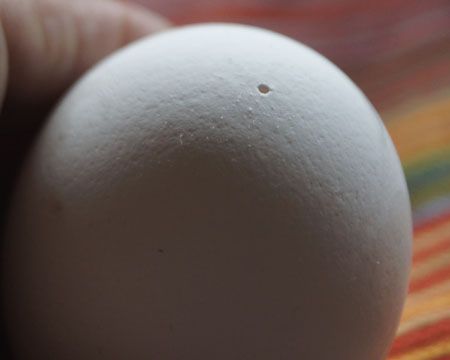
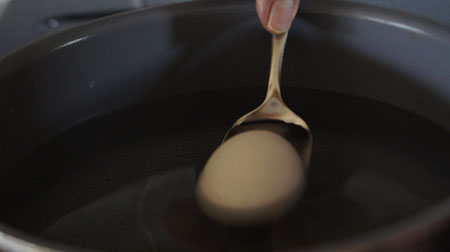 As careful as I was to remove the eggs from the carton properly and poke what looked like the flatter end, one of the eggs had been put in the carton upside down was thus in the wrong orientation (the upper left egg in the pattern of six). Instead of bubbles, white goo came out when I lowered it into the boiIing water. I removed it immediately. Here is the gooey egg white coming out of the hole in the upper left egg:
As careful as I was to remove the eggs from the carton properly and poke what looked like the flatter end, one of the eggs had been put in the carton upside down was thus in the wrong orientation (the upper left egg in the pattern of six). Instead of bubbles, white goo came out when I lowered it into the boiIing water. I removed it immediately. Here is the gooey egg white coming out of the hole in the upper left egg: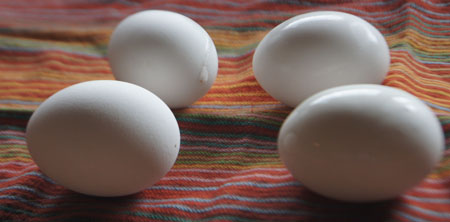
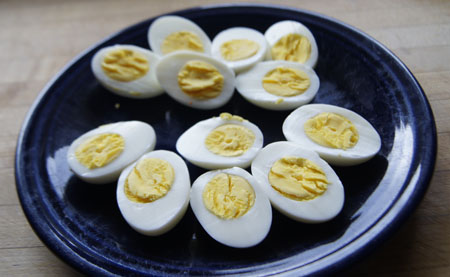 Conclusion: In my opinion, the 15-minute eggs were a bit undercooked. Here is a close-up, with a 15-minute egg on the left, and a 20-minute egg on the right:
Conclusion: In my opinion, the 15-minute eggs were a bit undercooked. Here is a close-up, with a 15-minute egg on the left, and a 20-minute egg on the right: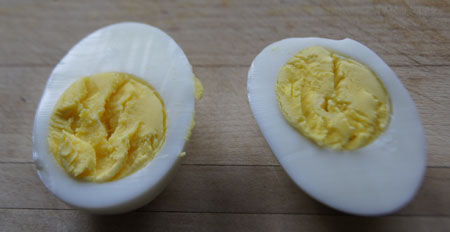 Neither has a dark green discoloration on the sides of the yolk.
Neither has a dark green discoloration on the sides of the yolk.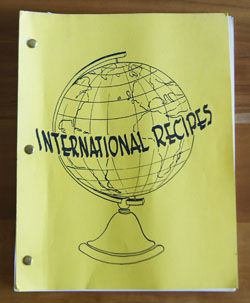 No author, no publisher, no publication date! This is the only cookbook in my collection with none of that information. It is a
No author, no publisher, no publication date! This is the only cookbook in my collection with none of that information. It is a  I read through this entire book, and am impressed with the author’s work. She (I assume it was a woman, at least) set up each section with an entire menu of recipes for the particular international cuisine. She referenced a sauce from one section (a raspberry sauce) that might go with a recipe from another section (a pecan torte). Because of the consistent writing style and the cross-references, I think this book was all written by one person, although she may have collected ideas from friends of different cultures. The recipes call for canned or processed items, like bean sprouts, canned shrimp and crab, and cake mixes; canned coconut milk was not available; there are several gelatin salad recipes; and microwaves and food processors are not mentioned. All of these facts lead me to believe it was produced in the sixties or seventies. Plus, it was prepared on a typewriter, not a computer.
I read through this entire book, and am impressed with the author’s work. She (I assume it was a woman, at least) set up each section with an entire menu of recipes for the particular international cuisine. She referenced a sauce from one section (a raspberry sauce) that might go with a recipe from another section (a pecan torte). Because of the consistent writing style and the cross-references, I think this book was all written by one person, although she may have collected ideas from friends of different cultures. The recipes call for canned or processed items, like bean sprouts, canned shrimp and crab, and cake mixes; canned coconut milk was not available; there are several gelatin salad recipes; and microwaves and food processors are not mentioned. All of these facts lead me to believe it was produced in the sixties or seventies. Plus, it was prepared on a typewriter, not a computer.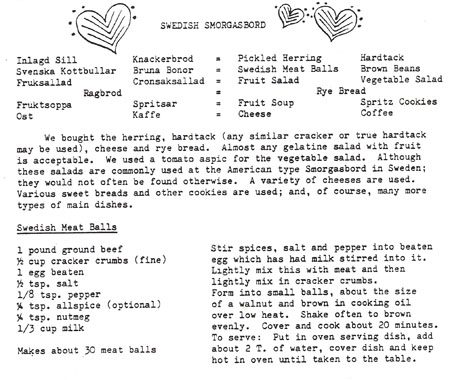
 Hungary: Hungarian Gulyas (like a goulash), Wilted Cucumbers, Cole Slaw, Cream Apples.
Hungary: Hungarian Gulyas (like a goulash), Wilted Cucumbers, Cole Slaw, Cream Apples.
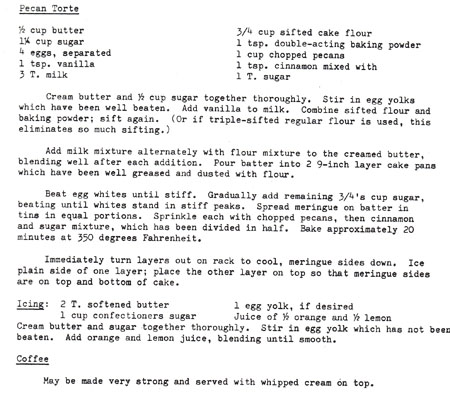
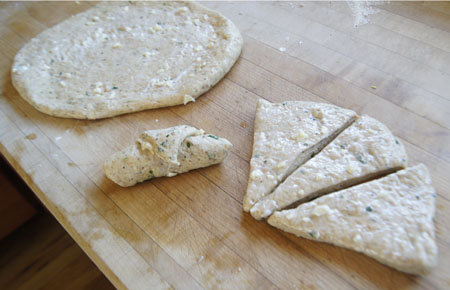 I put the rolls on 2 parchment-lined half sheet pans and let them rise about 20 minutes (my kitchen was warm). I learned from experience that the rolls bake up best if you tuck the pointy ends under the rolls.
I put the rolls on 2 parchment-lined half sheet pans and let them rise about 20 minutes (my kitchen was warm). I learned from experience that the rolls bake up best if you tuck the pointy ends under the rolls.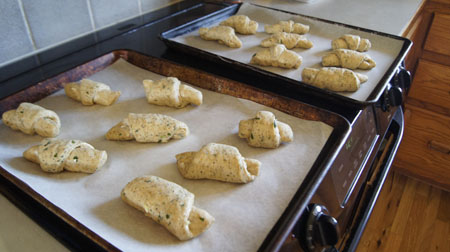
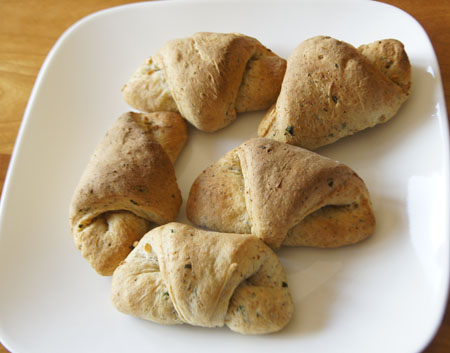 A “yum” for this recipe! These are soft and tasty, and fun to make. The bread machine method worked great. I put some of the rolls in the freezer for later use. Yes, I’d make these again!
A “yum” for this recipe! These are soft and tasty, and fun to make. The bread machine method worked great. I put some of the rolls in the freezer for later use. Yes, I’d make these again!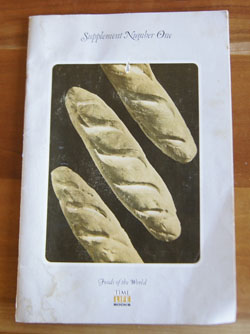 I own 5 of the 27 Foods of the World volumes produced by Time-Life Books, and have covered 4 of them so far:
I own 5 of the 27 Foods of the World volumes produced by Time-Life Books, and have covered 4 of them so far:  Note in the above discussion that in France, most people buy their bread fresh daily in the bakeries, or
Note in the above discussion that in France, most people buy their bread fresh daily in the bakeries, or 
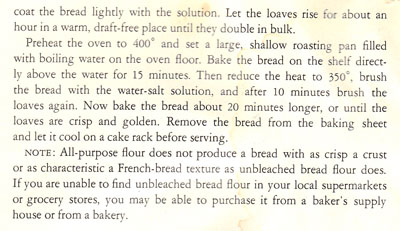
 I also added 1 egg white to the dough. I forget where I got that idea, but I found it essential for making a good loaf. I also added 1 tablespoon shortening – I forget why. I discovered early on the advantage of adding vital wheat gluten flour to my loaves, so the changes I made to the recipe include using 1/2 cup gluten flour in the total 4 cups of flour, (the rest was all-purpose flour).
I also added 1 egg white to the dough. I forget where I got that idea, but I found it essential for making a good loaf. I also added 1 tablespoon shortening – I forget why. I discovered early on the advantage of adding vital wheat gluten flour to my loaves, so the changes I made to the recipe include using 1/2 cup gluten flour in the total 4 cups of flour, (the rest was all-purpose flour).
 I am very pleased with the results. Granted, I made some of the slashes too deep so it may not look perfect, but the crust is golden brown and good and crunchy. The inside has a good “crumb”, sort of halfway between kneaded breads and no-knead breads. (No-knead breads are more like the artisan loaves we buy locally.) I like the flavor, too. Some chefs argue that true French bread has no milk or butter in it, but I like it this way.
I am very pleased with the results. Granted, I made some of the slashes too deep so it may not look perfect, but the crust is golden brown and good and crunchy. The inside has a good “crumb”, sort of halfway between kneaded breads and no-knead breads. (No-knead breads are more like the artisan loaves we buy locally.) I like the flavor, too. Some chefs argue that true French bread has no milk or butter in it, but I like it this way.